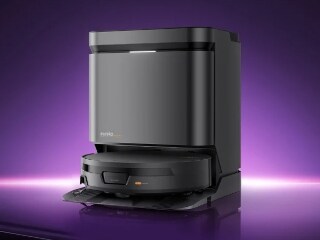- Home
- Science
- Science News
- NASA Shares Fascinating View of Three Galaxies And Explains Why They Are Unique
NASA Shares Fascinating View of Three Galaxies And Explains Why They Are Unique
Galaxies are not static, and their morphologies, and, therefore, classifications, vary throughout their lifetimes, says the agency

Photo Credit: NASA/ Twitter
NASA's post shows us how the Universe is ever-changing
NASA has shared a fascinating photograph featuring three different galaxies. And with that, the space agency has also explained how these galaxies don't let any "labels define them". Confused? Let's unpack. On June 13, NASA posted a photograph of three galaxies — one right in the centre and the other two spotted on the extreme right and bottom of the picture. The photo was captured by the wide-field camera 3 of NASA's Hubble telescope. Now, let's understand what makes these galaxies unique. In its Instagram post, the agency said that the galaxy pictured in the middle was "difficult to classify" and the reasons are very interesting.
While it is sometimes classified as a spiral galaxy, similar to our own Milky Way, it is also sometimes classified as a lenticular galaxy," the agency says. "Lenticular galaxies are a galaxy type that sits between spiral and elliptical varieties." Now, that makes it more complex, right?
But here's a simpler way of looking at it. NASA says the galaxies grow just as we do. "While the spiral arms of this galaxy are distinguishable, they're not clearly defined. Pictured here, the tip of one arm appears to be diffused," it says.
Galaxies are not static, and their morphologies (and therefore their classifications) vary throughout their lifetimes, says NASA in a separate note published on its website.
"Spiral galaxies are thought to evolve into elliptical. This can happen by merging with one another, causing them to lose their distinctive spiral structure," NASA says further in its Instagram post, explaining how even the galaxies change their composition with time.
The agency says that the spiral galaxy NGC 4680 in the middle is flanked by two other galaxies as we explained above. Interestingly, NGC 4680 enjoyed a wave of attention in 1997, playing host to a supernova explosion known as SN 1997bp, says NASA.
NASA shared the same picture on Twitter as well and a user wondered if the space agency ever flirted with the idea of sending its astronauts to one of these galaxies.
Have NASA ever thought about sending spacecraft to these galaxies to see if there is life. I think every galaxies that Hubble take pictures of should have a probe or unmanned spacecraft sent to it.. so we can find out what going on.
— TeeMichelle (@TeeMichelle57) June 12, 2021
Another user, though, explained why it was nearly impossible for NASA to undertake any such mission.
Way too far away. We cant even travel at the speed of light, (to current knowledge is impossible), and that would still take billions of years. Until we discover how to manipulate space time and utilise worm holes, it can't happen.
— Josh ???????? (@cfcjosh03) June 12, 2021
Here are some more Twitter reactions to the picture:
NASA team, excellent capture of three galaxies And impressive. I hope in the future we are going to Be able to observe in more detail. Professor Isagholian, astronomy, physics
— Leon Isagholian (@lbisagholian) June 12, 2021
My God, this galaxy is changing. Notice the change in direction of the star's light in the center of the galaxy.
— think_tec2020 (@TTec2020) June 13, 2021
Imagine the possibilities of the existence of alien life in one of those galaxies, and the potential that there's a life form more comical than Carot Top.
— Craig Wilson (@CraigWilson506) June 13, 2021
Wow! So magnificent! How I wish to be in one of those galaxies....
— ???? Stay Original! ???? (@Habeeblah2) June 12, 2021
Thank you for sharing this amazing photograph. What a sight this is. How fortunate that we are able to see this, to appreciate and benefit from the view . Remember everyone involved. The many people collaborating, the technology attained, to capture this moment in time. Wow!
— Melanie Spiropoulos (@dancetoACJ) June 12, 2021
The Hubble telescope, which captured the picture, was launched in 1990 as a collaboration project between NASA and the European Space Agency. The telescope has an unobstructed view of the universe.
Catch the latest from the Consumer Electronics Show on Gadgets 360, at our CES 2026 hub.
Related Stories
- Samsung Galaxy Unpacked 2025
- ChatGPT
- Redmi Note 14 Pro+
- iPhone 16
- Apple Vision Pro
- Oneplus 12
- OnePlus Nord CE 3 Lite 5G
- iPhone 13
- Xiaomi 14 Pro
- Oppo Find N3
- Tecno Spark Go (2023)
- Realme V30
- Best Phones Under 25000
- Samsung Galaxy S24 Series
- Cryptocurrency
- iQoo 12
- Samsung Galaxy S24 Ultra
- Giottus
- Samsung Galaxy Z Flip 5
- Apple 'Scary Fast'
- Housefull 5
- GoPro Hero 12 Black Review
- Invincible Season 2
- JioGlass
- HD Ready TV
- Laptop Under 50000
- Smartwatch Under 10000
- Latest Mobile Phones
- Compare Phones
- Motorola Signature
- Vivo Y50e 5G
- Vivo Y50s 5G
- Realme 16 Pro+ 5G
- Realme 16 Pro 5G
- TCL Nxtpaper 70 Pro
- OPPO A6 Pro 5G
- Honor Power 2
- Zephyrus Duo 16 (2026)
- Asus ROG Zephyrus G16 (2026)
- Realme Pad 3
- OPPO Pad Air 5
- Xiaomi Watch 5
- Huawei Watch 10th Anniversary Edition
- Acerpure Nitro Z Series 100-inch QLED TV
- Samsung 43 Inch LED Ultra HD (4K) Smart TV (UA43UE81AFULXL)
- Asus ROG Ally
- Nintendo Switch Lite
- Haier 1.6 Ton 5 Star Inverter Split AC (HSU19G-MZAID5BN-INV)
- Haier 1.6 Ton 5 Star Inverter Split AC (HSU19G-MZAIM5BN-INV)

















